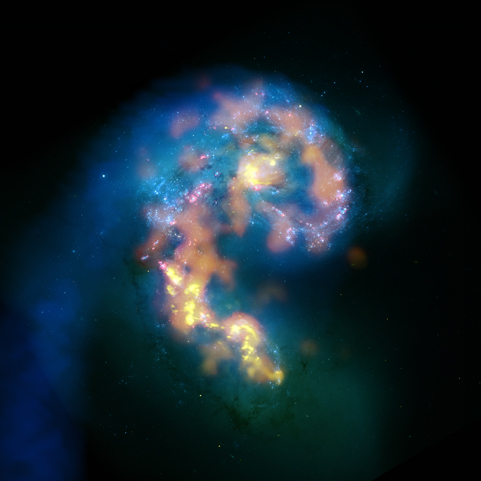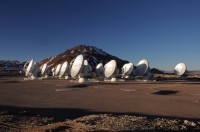Multiwavelength composite of interacting galaxies NGC 4038/4039, the Antennae, showing VLA radio (blues), past and recent starbirths in HST and CTIO optical (whites and pinks), and a selection of current star-forming regions in ALMA’s mm/submm (orange and yellows) showing detail surpassing all other views in these wavelengths. (NRAO/AUI/NSF; ALMA (ESO/NAOJ/NRAO); HST (NASA, ESA, and B. Whitmore (STScI)); J. Hibbard, (NRAO/AUI/NSF); NOAO/AURA/NSF.)
Home Multiwavelength composite of interacting galaxies NGC 4038/4039, the Antennae, showing VLA radio (blues), past and recent starbirths in HST and CTIO optical (whites and pinks), and a selection of current star-forming regions in ALMA’s mm/submm (orange and yellows) showing detail surpassing all other views in these wavelengths. (NRAO/AUI/NSF; ALMA (ESO/NAOJ/NRAO); HST (NASA, ESA, and B. Whitmore (STScI)); J. Hibbard, (NRAO/AUI/NSF); NOAO/AURA/NSF.) Multiwavelength composite of interacting galaxies NGC 4038/4039, the Antennae, showing VLA radio (blues), past and recent starbirths in HST and CTIO optical (whites and pinks), and a selection of current star-forming regions in ALMA's mm/submm (orange and yellows) showing detail surpassing all other views in these wavelengths. (NRAO/AUI/NSF; ALMA (ESO/NAOJ/NRAO); HST (NASA, ESA, and B. Whitmore (STScI)); J. Hibbard, (NRAO/AUI/NSF); NOAO/AURA/NSF.)
Multiwavelength composite of interacting galaxies NGC 4038/4039, the Antennae, showing VLA radio (blues), past and recent starbirths in HST and CTIO optical (whites and pinks), and a selection of current star-forming regions in ALMA’s mm/submm (orange and yellows) showing detail surpassing all other views in these wavelengths. (NRAO/AUI/NSF; ALMA (ESO/NAOJ/NRAO); HST (NASA, ESA, and B. Whitmore (STScI)); J. Hibbard, (NRAO/AUI/NSF); NOAO/AURA/NSF.)




